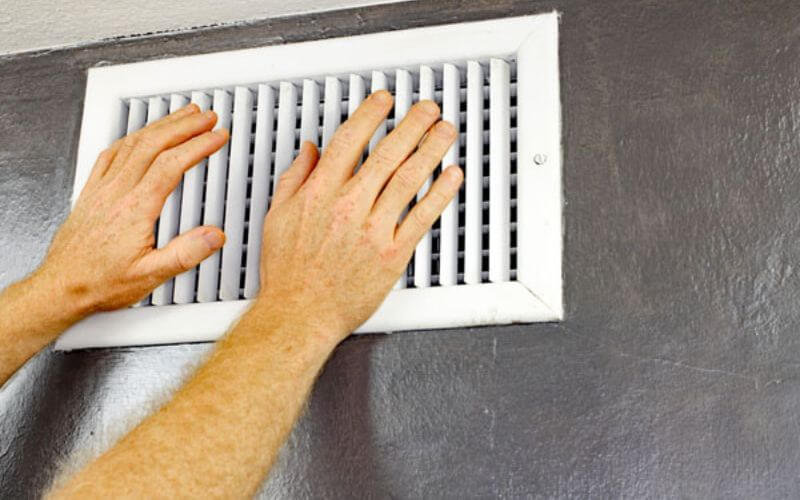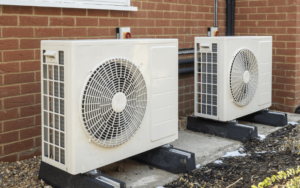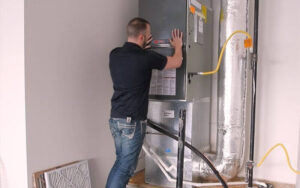[vc_row][vc_column][/vc_column][/vc_row][vc_row][vc_column][vc_column_text]Proper air circulation keeps the room at a comfortable temperature and humidity level. However, airflow in some rooms may be insufficient. How can I improve airflow in the room? We discovered that you could increase the airflow into the room by increasing the vents that supply the room with conditioned air.
You can also use a fan, close vents in other rooms, and open windows and doors. HVAC maintenance also aids in increasing airflow.
Continue reading to learn how to improve the airflow in the room. It also investigates why some vents aren’t blowing air and discusses the significance of proper airflow in the home. Let’s get started right away.
Table of Contents
ToggleHow do You Maximize The Flow of Air Into The Room?
There is a significant difference in room temperature, particularly during the summer. This makes for an uncomfortable living environment and may pique your interest in maximizing airflow into the room. Increase the airflow to eliminate hotspots.
Also, check: Best Tent Air Conditioners for Camping.
Increase The Size of The Room’s Ventilation Openings:
The HVAC system includes a diffuser as well as a duct. Vents are a network of metal ducts that run from the central HVAC machine throughout the house. These vents return conditioned air to the room and unconditioned air to the HVAC unit.
Ventilation, on the other hand, is the point at which the duct enters the room. The air supply port draws in from inside to heat or cool it, and the return airport sends temperature-controlled air into space. Even when the air nozzle is expanded, the air pressure inside the duct remains constant.
Increasing the frontal area of the vent, on the other hand, increases airflow due to a constant frontal velocity-the wider the opening, the slower the resistance due to the reduced resistance, which increases airflow.
The most effective way to increase airflow in the room is to enlarge the vents, but this is not a do-it-yourself project. It is also expensive because it necessitates drilling to increase the size of the opening.
Increase The Number of Vents:
Adding more vents to a room expands the ducts through which air enters and exits the room, resulting in increased airflow. Before installing new vents, have an HVAC professional inspect your heating and cooling system.
If the proposed vents change the pressure rise in the duct, the airflow in other rooms may suffer.
Other Rooms’ Ventilation Openings Should Be Closed:
The pressure inside the duct is increased by closing the vents in different rooms. As air pressure rises, so does air velocity, resulting in more incredible surface velocity through open vents. This will improve airflow.
However, only a few ventilation slots should be closed at a time and not be left closed for long periods. Increased pressure caused by duct sealing can cause leaks in the system, resulting in costly repair costs.
Closing the vents puts strain on the HVAC system while the HVAC technician adjusts the size to meet your requirements. It isn’t easy to redistribute regulated air across open vents, which reduces system efficiency.
As a result, closing the vents is a temporary solution for increasing airflow in the room.
Set Up The Fan:
Installing a ceiling fan is a low-cost way to improve airflow in the room. Although fans do not generate cold air, the movement of air can cool the wind. The disadvantage of using a fan to maximize airflow is that its effect is limited to the area directly beneath the fan.
Use Portable Fans:
Portable fans are adaptable and can be strategically positioned to direct airflow within a room. Placing fans near windows or open doors can aid in drawing in the fresh air while setting them to circulate air within the room can aid in the efficient distribution of cool or warm air.
Rearrange your Furniture:
Arrange the furnishings to promote ventilation throughout the room. Allow air to circulate freely throughout the space by not blocking vents. Consider utilizing furniture that saves space and does not block air circulation.
Insulate and Seal:
Proper insulation and sealing gaps or breaches in windows, walls, and doors can assist in minimizing air leakage, allowing the area to keep a steady temperature and airflow.
Open Your Windows And Doors:
I am opening a room’s windows and doors result in a better airflow distribution pattern than using a fan. Cross-ventilation is most effective when the windows and doors on the opposite side are opened. By opening the highest and lowest windows in a room, you can also take advantage of the difference in air density between hot and cold air.
Warm air rises and exits through the upper window, while cool air enters through the lower window. This method is simple because it does not require drilling holes in the wall or mounting fans to increase airflow.
Consider Installing A Duct Booster Fan:
A duct booster fan might be a handy addition if the airflow from your HVAC system is insufficient. It can improve the dispersion of warm or cooled air to a given room, resulting in a more comfortable atmosphere.
Upkeep of HVAC Systems:
As the air supplied to the room passes through the filter, cleaning the filter improves the airflow into the room. Filters that are clogged restrict airflow and prevent proper air circulation.
Cleaning the vents and ducts can also help to improve airflow by removing blockages. HVAC technicians can also inspect and repair leaks in ductwork. Also, ensure no obstructions, such as furniture or other equipment, are in the way of the vents. You can also request that a technician reset the fan speed on your air conditioner.
Increasing the fan speed improves airflow. The air conditioner will circulate throughout the day if you set it to fan mode. The HVAC setting influences airflow throughout the system’s network, not just in one room.
Also check: Can A Portable Generator Run a Central Air Conditioner?
What is The Cause of Some Vents Not Blowing Air?
Some rooms may become unavailable due to a lack of air conditioning. Unfortunately, air vents are very common in homes, especially during the summer. There could be several reasons why the ducts aren’t blowing air.
The Flex Duct is Twisted:
Flexible pipes, as the name suggests, are pliable. As a result, if something falls, it may fall off or tear. It may also bend or sag if installed incorrectly. These ducts’ bending can obstruct airflow into the room.
Disconnected Air Ducts:
Ducts leading to the room may become disconnected from the main and obstruct airflow into the room. Because the duct system is not vacuum-installed, heavy objects can exert pressure on the duct and cause it to loosen. Neglect also contributes to the sewer system’s failure.
Air Leak:
Due to duct leaks, conditioned air from the HVAC unit may not reach the room. Sewer leaks affect approximately 75% of all households. Furthermore, most homes lose 10% to 25% of temperature-controlled air. Technical experts can use infrared technology to locate the gap in the channel.
Leaks, on the other hand, can be detected by significantly increasing heating and cooling bills. Furthermore, your home will have uneven temperatures, and your HVAC unit will need frequent repairs.
The Damper is Closed:
The HVAC vent flap controls the duct’s airflow. When they are closed, no air flows through them. As a result, some vents are unable to blow air.
How Necessary is Proper Airflow?
The global coronavirus pandemic has heightened awareness of the importance of proper home ventilation. The improved airflow prevents virus particles from accumulating and thus reduces the number of infections. However, there are additional advantages to improving air circulation in the home.
Increases HVAC Durability:
Because the HVAC system is designed to operate within a specific airflow range, maintaining these ratios ensures that the equipment will continue to function for the duration of its expected useful life. Premature component failures, such as compressor and motor failures, should be avoided. Proper air circulation keeps the heat exchanger from cracking and the indoor coil from freezing.
Increased Device Efficiency:
The HVAC system must have adequate airflow to function correctly. This air circulates in a circular motion from the device into the room and back to the device. As a result, with adequate airflow, the HVAC unit will be more efficient.
Keep You Safe:
When inhaled, dust, pollen, and other allergens can cause respiratory infections. Proper air circulation removes these particles from the home. Adequate airflow is required even when using fuel-powered equipment to reduce the risk of carbon monoxide poisoning.
Increases Comfort:
Proper airflow aids in regulating temperature and humidity, which is critical for home comfort.
Reduces The Possibility of Condensation:
The Increased Airflow aids in the removal of excess moisture from the house, which would otherwise cause the wooden structure to rot. Improved air circulation also helps to keep mold and stains at bay. Mold thrives in moist environments, and inhaling these particles can be hazardous to your health. It can also lower your home’s value.
Conclusion:
You can control airflow in your home by using proper ventilation. Natural methods, such as opening windows, can increase airflow in the room.
You can also use the mechanical methods listed below: Install a fan or increase the size of the ventilation openings. Improving airflow increases the device’s efficiency and extends its service life. By removing pollutants, proper airflow keeps you and your loved ones healthy.[/vc_column_text][/vc_column][/vc_row][vc_row][vc_column][/vc_column][/vc_row]





















